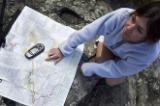Natural Geographies
Have you ever stood on the state line, hopped across into your neighboring state, and hopped back? Not much to it after the third or fourth time, right? This is nature's first lesson: No human-made boundaries really apply to the landscape. Any changes that occur are more often gradual and related to complex ecological truths, rather than political, historical, or economic variables. Effective conservation often requires that we work across these jurisdictional boundaries, looking instead to more naturally defined areas.
Hence, the grouping of "natural geographies." They differ in scale because it is useful, on occasion, to refer to places based on specific scientific criteria -- sometimes large, sometimes small. Yet, Ecoregions, Ecological Divisions, Watersheds, and Corridors can all provide valuable frameworks for shaping on-the-ground land and water protection efforts.
Explore Natural Geographies
-
Wildlife Connections
Conservation biologists have shown that the construction and preservation of wildlife linkages between habitat patches can help maintain plant and animal populations while offsetting the negative effects of habitat fragmentation.
-
Ecoregions
Perhaps our most useful framework for visualizing and describing regional biodiversity, ecoregions transcend political and jurisdictional boundaries and help conservationists keep natural terrain, ecology, and conservation priorities front and center.
-
Watersheds
Follow the water, they say. In land issues, this means attending to the watershed -- a region where rainfall and snowmelt drains into a stream, lake, or other body of water. Watersheds play a crucial and effective role in local and regional conservation planning and action.
-
Ecological Divisions
The broadest of our natural geographies, Ecological Divisions grew out of the need to provide a larger ecological overlay to Ecoregions. They are bigger, often encompassing one or more Ecoregions, reflecting continent-scale observations of climate, physical description, and the biogeographic history of larger land areas.
Go Straight to Your State
Learn about conservation and open space in your state.






